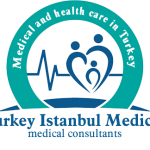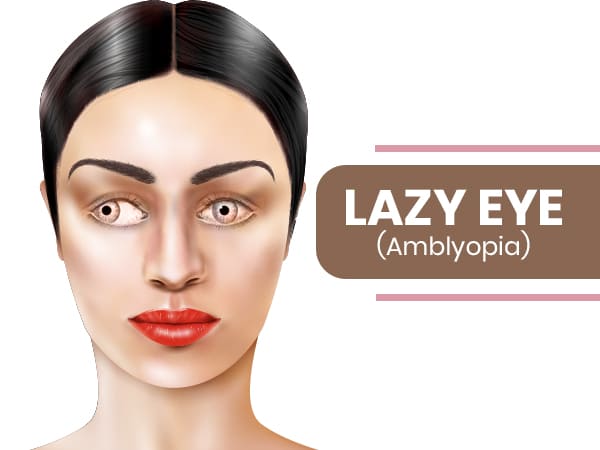What is Lazy Eye (Amblyopia)?
Amblyopia, also known as lazy eye, is the decrease in vision that occurs in one eye or sometimes in both eyes as a result of the inhibition of the normal development of the visual sense in early childhood. The diagnosis of lazy eye in early childhood is very important. If the diagnosis is delayed, it may cause permanent vision loss in advanced ages.
Although there are studies on lazy eye in adulthood, the results are not clear yet. Lazy eye, which cannot be recognized and treated in childhood, results in the loss of three-dimensional vision, which is no longer treatable in adulthood. Studies have shown that children with amblyopia in one eye are more likely to lose the other eye due to trauma.
How Common Is Lazy Eye (Amblyopia)?
The incidence of lazy eye in the society is 2-4%. The visual systems of newborn babies increase as the baby grows. The development of the visual system is very rapid in early childhood, especially in the first 2 years, and this development continues until the age of 9-10. For a normal visual development, the vision in both eyes should be equal and age appropriate in children in this process. Any situation that will disrupt normal visual development in a child in this process will result in lazy eye.
What Causes Lazy Eye (Amblyopia)?
There are multiple causes of lazy eye formation.
Common causes of the disease are as follows:
-
Strabismus:
Strabismus has passed into the medical literature as strabismus. It is the most common cause of the disease. There are six external muscles in each eye, and weakness in one of these muscles causes strabismus.
If strabismus in newborns does not go away after 6 months, this is considered a disease. In order for the child not to see double due to the sliding eye, the brain deactivates the side with the shift and perceives the image coming from only one side. Thus, lazy eye occurs.
-
Glasses Number Differences Between Two Eyes:
Refraction defects can be corrected with the use of glasses. Myopia, astigmatism and hyperopia problems in one eye cause blurred vision on one side compared to the other. This causes the brain to not perceive the image from one eye to create an optimized image perception.
As a result, laziness may occur when the refractive error, which has a high degree of refractive error, is not treated with glasses or contact lenses.
-
Low Eyelid:
Congenital or acquired droopy eyelids block the field of view by a minimum of 1 millimeter, preventing healthy vision. This situation can lead to the formation of the disease.
-
Blurring of Eye Tissues That Should Be Transparent:
The problem of cataract or clouding of the cornea causes the image that falls on the retina and thus transmitted to the visual center of the brain to be unclear.
As a result of this situation, the brain will only accept the image coming from the healthy side. This causes lazy eye.
What are the Symptoms of Lazy Eye (Amblyopia)?
If left untreated, amblyopia, which can lead to rapid decrease in visual acuity, loss of vision with both eyes, difficulties in perceiving depth, and loss of vision in healthy eyes, is very difficult for the person to notice because it occurs during the developmental period.
Strabismus, defined as strabismus in medicine, is the most common cause of lazy eye.
Although strabismus can be noticed from the outside, other causes are often at a level that families cannot notice.
However, some symptoms occur in the presence of lazy eye.
- Frequent blinking movement,
- Desire to close one eye, closing one eye manually,
- Rubbing the eyes or squinting,
- Requires eye and hand coordination; having difficulty in doing tasks such as holding a spoon and buttoning up,
- Turning the head to one side while looking at the focused object,
- Avoiding looking close,
- Distraction and contemplation.
Who is at Risk?
lazy eye; It is more common in babies born prematurely or small, in children with amblyopia and developmental disorders in other family members.
How is Lazy Eye (Amblyopia) Diagnosed?
In childhood, especially in diseases that develop before the speech period, it becomes difficult for children to describe their own ailments. They try to relieve their discomfort by developing some methods according to themselves. For this reason, families should be sensitive and careful about behavioral changes in children.
Children may not be able to express this discomfort because there is no pain and pain sensation in lazy eye.
Families;
- If they see signs of hand-eye coordination disorder in their children,
- Seeing near or far (to get too close to the TV, to the book, avoiding reading, indifference to lessons at school age,
- The need to turn their head one to one) side to side while reading or watching something, etc.).
- Strabismus or squinting of the eyes
It is a good idea to consult an ophthalmologist without looking for other symptoms.
The diagnosis of lazy eye is made by eye examination. In the examination, it is checked whether there is a shift in the eyes and visual impairment in one or both eyes.
In some cases, a drop may be used to enlarge the pupil. This decrease causes blurred vision. However, the drop loses its effect within 3-4 hours. And this blur disappears.
In the eye examination before the speaking age in children;
- In the eye examination performed before the children’s speaking age, it is checked whether there are situations that prevent the visual axis and whether the child can follow an object in a coordinated manner with both eyes.
- Autorefractometry or skiascopy measurement is performed to determine whether there is a high degree of refractive error in the 1-year-old examination.
- In older children, visual function tests are done with letters or pictures.
Why Does It Occur in Childhood?
In order for the visual function to develop normally, sufficient light must reach the retina layer of both eyes. In addition, the clarity of the images falling on the retina should be the same or similar.
Although childhood is important for a normal visual function, the first year of life is very important. In this process, the eye and brain are rapidly developing and changing. For this reason, lazy eye occurs when the brain suppresses the stimulus from one or both eyes in the way I described above.
Lazy Eye (Amblyopia) Treatment
Surgery has no place in the treatment of lazy eye. The first 10 years are more advantageous in the treatment of lazy eye and the increase in vision is achieved more easily. The main treatment methods used in lazy eye are as follows;
-
Closing Technique
The purpose of occlusion treatment is to close the good eye and operate the weak eye. The closure time varies according to the age of the patient and the level of lazy eye.
The younger the age, the shorter the closure time and the shorter the treatment time.
-
Orthoptic Treatment
Orthoptic treatment is the treatments applied in the hospital, in a sense, it is the physical treatments applied to the eye. In orthoptic treatment, eye-activating applications are made in addition to the occlusion treatment. Session duration is approximately 40 minutes.
-
Computer Programs
This treatment can be applied to children over 5 years old. They are interactive programs consisting of various games designed to help with occlusion therapy.
The aim is to increase the visual capacity of the lazy eye. It is applied at home and the patient is called for monthly vision control. This program, which consists of 150 sessions and lasts up to 5 months, is applied at home.
-
CAM Treatment
A special device is used in the treatment of CAM. The treatment is applied in the hospital, each session lasts an average of 30 minutes and a total of 10 sessions are applied.
-
Visual Therapy Applications
It is a treatment method consisting of exercises for the eye to gain a sense of depth. It consists of studies made with specially prepared instruments and image techniques. With these techniques, for example, the lazy eye can gain three-dimensional vision and a sense of depth, and the performance of the eye can be increased.
-
Neurovision™ Treatment
Neurovision™ treatment is a treatment method applied to people between the ages of 10-55 and whose eye structure is suitable.
In this treatment method, lazy eye treatment is performed under the control of a doctor with a program loaded into the computer system.
In this treatment, which is applied using computer technology, the brain is taught to see again. And with this method, it is aimed to increase the ability to see.

